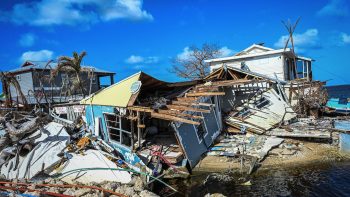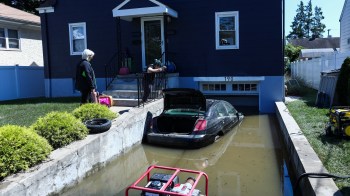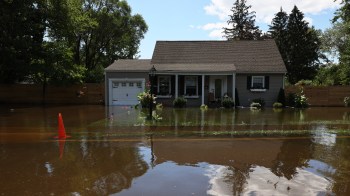
As hurricanes get more severe, how do insurers calculate risk?
As hurricanes get more severe, how do insurers calculate risk?

In June, insurance companies State Farm and Allstate announced they would no longer write new policies for California homeowners. The companies cited construction costs and the exposure to costly natural disasters in explaining their decisions. When it comes to catastrophic weather events, how are insurers estimating the cost of the damage?
Over the past couple of years, insurance companies have used “catastrophe models” to predict the possible costs of events like wildfires and hurricanes. “Marketplace” host Amy Scott spoke with Karen Clark of Karen Clark & Co., a leader in the catastrophe modeling industry, about how climate change is influencing extreme weather and what to expect from the 2023 hurricane season.
The following is an edited transcript of their conversation.
Amy Scott: What do we know about how climate change is affecting hurricanes?
Karen Clark: Well, of course, there is a lot of uncertainty around climate change impacts. But at KCC, we go to the ultimate source of information. And that’s really the IPCC reports, the Intergovernmental Panel on Climate Change. And what they include in these reports are they analyze all the scientific research going on all around the world, and they pretty much embody the scientific consensus. I think it’s important for people to know that there’s a lot of uncertainty, and there are dozens of different models and they can produce radically different results. In the IPCC reports, we have synthesized for us the consensus — and for hurricanes, there’s currently scientific consensus that hurricanes are not becoming more frequent, but they’re becoming more severe. And so we’re seeing a shift to a higher proportion of major hurricanes — that is, Category 3, 4 or 5.
Scott: NOAA, the National Oceanic and Atmospheric Administration, has predicted a “near-normal” hurricane season for 2023. First of all, what does that mean? And what are your models telling you about potential damage this season?
Clark: Well, first of all, there’s considerable uncertainty around the forecasts, and particularly this year, because we have two conflicting influences on hurricane activity. One is, of course, the very warm sea surface temperatures, which does lead to or should lead to a highly active season. But we also believe that we’re starting the El Niño phase, which means more vertical wind shear, and this is bad for hurricanes. But in reality, these forecasts don’t really matter that much to insurance companies or other types of property owners because, if you think about it, the population is not uniform along the coastline. So, what causes a very large insured loss is a major hurricane striking a highly populated area such as Miami or around Fort Myers, like we had last year with Hurricane Ian. So I think you know, Amy, one of my favorite sayings: “Hurricanes are like real estate. What are the three most important things? Location, location, location.”
Scott: We’ve seen generally insurers pulling back from risky areas. Earlier this year, State Farm and Allstate said they would stop writing new policies in California due to catastrophe risk. And the high cost of rebuilding, as we’ve talked about, this has been happening in Florida and other coastal areas as well. Is it going to get a lot harder for people to live in these areas because of the insurance situation?
Clark: It is becoming more costly, and that’s because the risk is going up. Now, insurance companies — as long as they’re able to quantify the risk and are able to manage it, then they can write the insurance. But it’s very important that homeowners understand that the price has to be commensurate with the risk. So, as you pointed out, construction costs are going up even higher than the general rate of inflation. And that is a big factor in the homeowner’s premium. Now, you mentioned Allstate and State Farm moving out of California, and these companies also moved out of Florida after Hurricane Andrew in 1992. But what happened in Florida, and we anticipate this to happen in California, is that the void can, or at least part of the void, hopefully will be filled by new companies that are formed specifically to specialize in this type of risk.
Scott: But as you know, the other company that stepped in to fill the void in Florida after Hurricane Andrew was Citizens, the state-backed insurer of last resort, which in many places is now the only provider of storm coverage. Is there a risk of the state or government insurance programs holding too much of the bag?
Clark: I guess the heart of the matter really is that there are some very risky areas, particularly in Florida, that are really difficult to insure at a price that people can afford. And in those areas, if the state still wants a homeowner to be able to buy insurance at more affordable rates, then they create a company like Citizens that will be able to provide it to people. But the real issue is who’s going to pay for the risk? Because if homeowners themselves are not paying for the risk, then of course the taxpayers are paying for it. And either it’ll be the state taxpayers or the federal taxpayers. So, the question then becomes, who will be paying for this risk and over what time period?
There’s a lot happening in the world. Through it all, Marketplace is here for you.
You rely on Marketplace to break down the world’s events and tell you how it affects you in a fact-based, approachable way. We rely on your financial support to keep making that possible.
Your donation today powers the independent journalism that you rely on. For just $5/month, you can help sustain Marketplace so we can keep reporting on the things that matter to you.

















